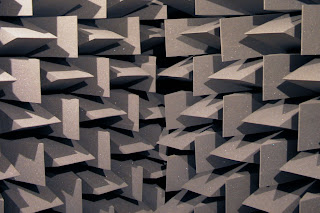We reviewed the last session which was on video – since then the group have been busy filming and recording interviews around the school. Mark picked these up on Monday and so we reviewed them today. After all – What makes a good recording? John (our video artist) had sent some feedback on the video interviews – he thought they were really good but a couple of pointers for the future included thinking about filling the frame more by having some close-up shots of the interviewer and interviewee and also leaving a gap before and after the interview to help with the editing process. All in all though, everyone had done a really good job!
Throughout we used the free, PC/Mac sound editing software Audacity considering it as a word processor for audio, as we are able to cut/paste and arrange sections of a recording into a new, different version and apply specifc effects to different sections to enhance them or change how they sound. Audacity is mainly a stereo audio editor – stereo refers to the fact that we use two microphones to record the material as when we listen to the results they are played back over two loudspeakers (or headphone loudspeakers) for our two ears. We also looked at the waveform display and how it represented an audio signal.
The first example was from the interview with Mr Nihill. There was lots to listen out for, but the main point was the very, very quiet recording and the high level of noise or hiss that could be heard – due to the recording being so quiet.
The second example was a recording that was too loud – everyone agreed that it sounded harsh to listen to, and the waveform itself looked very different to the previous example – in some places it went completely off the scale. This is called clipping distortion.
In the next case we returned to the interview with Mr Nihill – this time noting the background noises clearly evident in the form of other school kids playing outside the recording room. We then listened to another example where air conditioning could be heard ‘underneath’ the main recorded material. This became most evident when it was turned off – although not everyone could hear it.
The next example came from the interview with Mr Riley. It was really easy to spot the problem – there were many horrible spikey noises, most likely from the table the recorder was sitting on being knocked every now and then.
We also considered the quality of the sounds across the recordings. We noted what makes a sound quiet or loud (microphone placement, recording input level on the actual recorders), echoey or not, and we noticed that the interview with Mr Riley sounded quite ‘boxy’ – most likely due to sound reflecting off a wall or large surface and interfering with the original signal.
Finally we played a sound that was ‘just right’. It was the school bell recorded up close and at just the right level. It sounded great and is available for download here.
We next introduced the idea of trying to keep the meaning or intention of our recordings when editing. It is easy to use an audio editor to change the order of words to make them mean something else – and it is our responsibility to make sure we represent our interviewees accurately. We listened to an example relating to the choice of Mr Nihill’s favourite book but I think everyone spotted the right version!
We did a quick demo of near and distant microphone placement using Mr Riley and Kirsty and listening to them via both microphones. They were clearly a lot quieter and more echoey in the microphone furthest away from them.
We returned to the studios where the group was split in two. They first had a go at editing some of the interviews and made a very good job – mistakes, pauses and stutters were removed, as were the original questions and comments from the interviewer. We also considered the difference between what the interviewee was telling us (as fact) rather than what they thought, which was much more interesting and appropriate for this project. The groups managed to trim away a lot of the original recording – but what was left was much better and often hinted at thoughts and ideas the interviewees had rather than the facts they relayed.
Kippa Matthews joined us for the final part of the session. Next week he will be running the session on photographic portraits, but today he was there as official photographer and spent some time with the group getting some great pictures that we can use for publicity. This part of the session explored how to use sound to tell a story – the groups had to edit together a soundtrack that told a story starting with someone waking up, turning the radio on and brushing their teeth – what happened next? Despite running out of time both groups made a good attempt and had a clear idea of the story they wanted to tell.
Next week will be photographic portraiture – over the next few days try to take the opportunity to look at photos in magazines and newspapers – are they natural, staged or a true portrait? Bring some examples along for us to look at and discuss.

